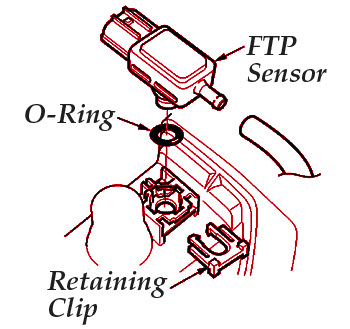Concern:
The MIL comes on with one or more of these evaporative DTCs stored:
• P0451 (FTP sensor circuit range/performance problem);
• P0452 (FTP sensor circuit low voltage);
• P0453 (FTP sensor circuit high voltage);
• P1454 (FTP sensor circuit range/performance problem).
Probable Cause: The fuel tank pressure sensor has an internal malfunction.
Corrective Action: Replace the fuel tank pressure sensor (P/N 37940-SDA-A01).
Diagnosis:
1. Connect the HDS to the DLC (data link connector).
2. Remove the fuel fill cap.
3. Turn the ignition switch to the On (II) position.
4. Select the PGM-FI data list, and observe the fuel tank pressure sensor voltage.
– If the FTP sensor voltage is between 2.46V and 2.56V, run the evaporative function test, and then follow normal troubleshooting procedures. This service bulletin does not apply.
– If the FTP sensor voltage is not between 2.46V and 2.56V, go to Repair Procedure.
Repair Procedure:
1. Remove the EVAP canister.
– Refer to page 11-330 of the 2005-’06 OH-V Service Manual, or
– Online, enter keyword EVAP, then select EVAP Canister Replacement from the list.
2. Inspect the fuel tank pressure sensor vent tube for blockage or poor connection. Then blow compressed air through the vent tube to clear any contamination.
3. Remove the retaining clip. See Fig. 1.
4. Remove the FTP sensor.
5. Install the FTP sensor with a new O-ring.
6. Install the remaining parts in the reverse order of removal.
Courtesy of Mitchell 1.













